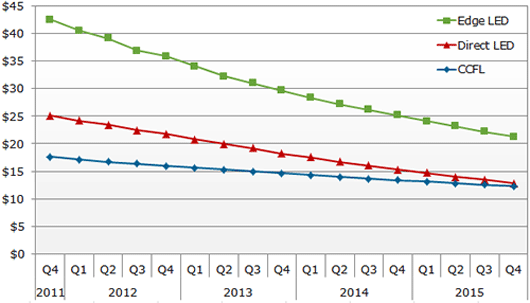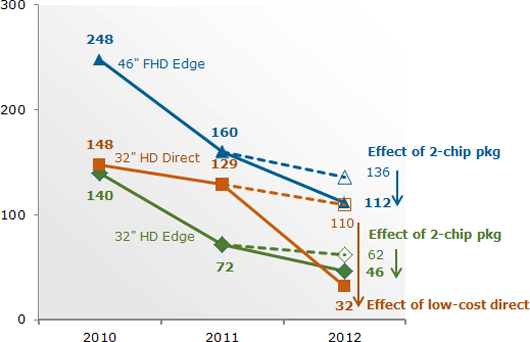- News
18 January 2012
Low-cost direct LED backlights to reduce premium for LED-backlit LCD TVs
Due to lower-than-expected consumer adoption of LED-backlit LCD TVs, TV makers have changed their strategy on direct LED-backlit TV to develop a product that uses less power and lowers costs by reducing the number of LEDs per TV set, according to the NPD DisplaySearch’s ‘Quarterly LED Backlight Report’. In turn, this also lowers brightness and moves away from the slim designs and higher picture quality that have been characteristic traits of LED-backlit LCD TVs.

Figure 1: Backlight Cost Forecasts for 32” HD 60Hz LCD TV Panel. Source: NPD DisplaySearch Quarterly LED & CCFL Backlight Cost Report.
“LED penetration in LCD TV was 7 points lower than our forecast a year ago, mainly due to high LED premiums,” says senior VP Yoshio Tamura. “The premium for a LED backlight in a 32" LCD TV was 42% in Q4/2011, although it had been expected to fall to 27%,” he adds. “Instead of high picture quality, set makers have chosen low-power consumption with a corresponding lower price as selling points for this new type of LED-backlit TV. This will increase its competitiveness with CCFL [cold-cathode fluorescent lamp]-backlit LCD TV and even CRT [cathode ray tube] TV.”
The materials cost for direct LED backlights comes closer to that of CCFL backlights. NPD DisplaySearch estimates that for 32” LCD TVs, direct LED backlights cost 1.3-1.4 times CCFL backlights, as opposed to edge-lit LED backlights, which are estimated to cost more than twice as much as CCFL backlights. For 40” LCD TVs, the savings could be even greater, with low-cost direct backlights cutting nearly $40 in material costs, which could result in as much as $100 in savings at retail.

Figure 2: Forecast of LED Packages per Set for TVs. Source: NPD DisplaySearch Quarterly LED Backlight Report.
The cost savings come from using about half as many LEDs, as well as the replacement of light guide plates, optical film, and other materials with lower-cost diffuser plates and lens structures on the LEDs. The reduction in LEDs and other materials lowers power consumption, but requires a thicker profile. Brightness is lowered to 300 nits from 450 nits for edge-lit LED or CCFL, and the lack of dimming reduces the contrast ratio and image quality.
TV makers have been adopting two-chip LED packages to reduce the number of packages and to reduce optical film use. The number of LED packages used per set with direct backlights is expected to be less than that of sets with edge backlights.
HB-LED market to grow just 8% to $9bn in 2011 instead of $10.6bn
Penetration of LED backlights into LCD TVs to grow from 21% to 53% in 2011
Large-size LED-backlit LCD panels to reach 67% market share in 2011
LED pricing pressure extending into Q1/2011
